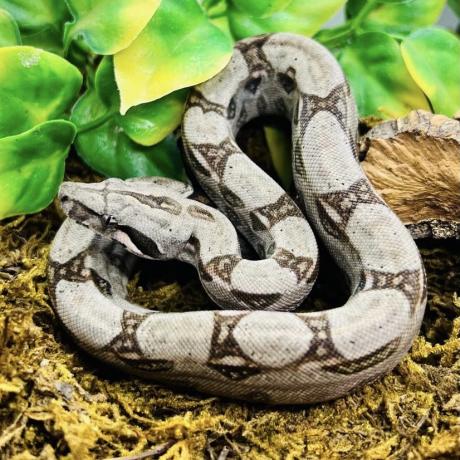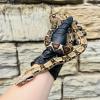

The Common Boa Constrictor can reach an adult length of 12ft but averages between 5-9ft. This species makes a great exotic pet, however a large enclosure is required when adult.


Neonate (baby) Common Boa Constrictors are approximately 12 inches when born. Adults average between 5-9ft, although some large females may reach lengths of 12ft and weigh up to 27kg. The colouration can vary widely depending upon the locality and morph, but their wild type colouring is generally tan with large dark brown to ruby red saddle patterns running along the dorsal of the body, which darkens towards the tail. A diamond pattern runs down each side of the body, usually with a lighter pattern inside. They have a dark line running from the nose, through the eye and towards the neck. Youngsters are normally brighter in colouration, which starts to darken with age.
With regular, patient handling, young Common Boa Constrictors will grow out of their initial instinct to strike defensively and become tame. Regardless of the temperament of the snake, caution should always be taken with snakes over 5ft and it is recommended to have two people present while feeding and cleaning.
On average, this species will live for approximately 20-30 years, one has been recorded at 40 years of age, so they are understandably a big commitment.
They originate from Central America, South America, Mexico and Columbia. Preferring to live in rainforests and along the coast, where prey is abundant and humidity is higher.
First and foremost, this species requires a lot of space - they need more than a basic vivarium to let them thrive. Common Boas, especially younger snakes are notoriously food driven and will often strike before realising there is no food present, they can also be (understandably) defensive. For more experienced keepers who understand how to read a snakes body language and are confident in handling, these snakes will generally calm down well and become tame. We ask that you seriously consider whether you can provide the animal with everything it requires for the duration of its life. Larger snakes do not generally make good pets for families with young children, as even the most docile animal has the potential of causing damage should it strike. It is our responsibility to ensure that you are well informed with regards to knowing what keeping a large snake entails, we would rather put people off buying than sell these animals to unsuitable or irresponsible owners and have them being rehomed or dumped.
Young common Boas are semi arboreal, which means that wherever you house them they will utilise vertical space readily. As they become larger, they tend to spend more time on the ground - but will still climb if given the opportunity. The vivarium needs to be of considerable measurements, for an adult female the minimum space required is something near to 2.4 x 1.2 x 1.2m (8ft x 3ft x 3ft) males can be kept in a slightly smaller enclosure if necessary.. For juveniles up to 1m long, a 120 x 60 x 60cm (4 x 2 x 2ft) vivarium is the absolute minimum. From an enrichment viewpoint, most Common Boas will require plenty of cork bark and branches to create multiple levels. Plants and hiding caves will also be readily enjoyed by these intelligent creatures. Environmental enrichment is hugely important for a snakes mental wellbeing, they are often less defensive when they feel safe and settled in their vivarium.
We recommend using a Coir based substrate mixed with orchid bark maintained at around 60-70% humidity. They sometimes enjoy wallowing in water, provision of a large enough dish or pool to soak in is often enjoyed. For adults, many owners keeping these snakes in large enclosures opt to add in a pool with drainage underneath to make cleaning easier.
A temperature gradient is essential so that the boa can properly regulate its body temperature (thermoregulate) and digest foods properly. These snakes devour large prey in the wild and often spend hours motionless absorbing heat from the sun to aid digestion.
For larger enclosures it is easier to achieve the desired temperature gradient, the most common method for heating is to use a guarded basking bulb on a thermostat, often combined with Deep Heat Projectors or Halogens (again, controlled by thermostats.) Ideal temperatures need to range from around 22°C cool end, to a basking area of 32°C. At night time the lights should be turned off, or if room temperatures are lower than 20°C, a ceramic bulb (non light emitting) on a thermostat should be set to ensure the temperature does not drop too low.
With regard to UVB lighting, there is still a lot of outdated information suggesting that snakes do not require UVB but research has proven they absolutely do - nearly all life on our planet benefits from sunlight exposure in one way or another. Common Boas benefit significantly from access to UVB, requiring a Ferguson Zone of 2. UVB exposure plays a vital role from the synthesis of vitamin D3 and the absorption of calcium from animal bones, to the regulation of circadian rhythm, physical and mental behaviour and activity levels.
Feed your Common Boa on appropriately sized defrosted rodents. Common Boas are naturally greedy and it is easy to fall into the trap of overfeeding. With any species, growing large too quickly and becoming obese can result in health complications and ultimately the main cause of premature death from fatty deposits in their vital organs in extreme cases. The size of food given depends on the size of the snake, this shouldn’t be any larger than the widest part of the boas body. Young Common Boas should be fed around every 7-10 days, older Common Boas every 10-14 days and adults should be fed one large meal every 3-4 weeks. In the wild Common Boas will often gorge on a large meal but then not feed for months. If you consider the level of exercise this species has in the wild, they will burn off the excess fat far more quickly than a pet snake ever could. This means a regimented feeding structure every week is not necessarily the best option for this animal. It is best to make a log of when your snake eats and sheds its skin, this helps to spot any patterns or behaviours linked to the feeding cycle.
Please note: Our team reserves the right to refuse sale of this animal if we feel that the long term wellbeing or welfare is in question. Large reptiles come with challenges; from temperament to housing, equipment and upkeep costs. It is our responsibility to the animal to determine your experience levels and suitability; we apologise if this offends you, but our strict policies are in place for the protection of the animal to ensure it has the best possible life - animal welfare always comes before profit.